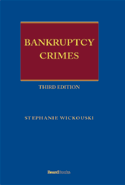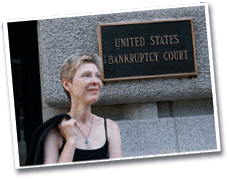
|
Bankruptcy Crimes: Third Edition
By Stephanie Wickouski
2007/08 - Beard Books
1587982722 - Hardcover - 415 pp.
US$264.95
Must reading for bankruptcy professionals.
Publisher Comments
This authoritative treatise on bankruptcy fraud is an invaluable reference book for bankruptcy law practitioners, white-collar criminal lawyers, prosecutors, judges, restructuring professionals, and academicians. Bankruptcy Crimes is the only book extant on the subject and is unique in its dual perspective and analysis of criminality and bankruptcy law. The
book explains, in a clear and captivating style, both the statutory intricacies of bankruptcy law as well as the fundamentals
of the related criminal offenses.
Among the topics covered are: fraud, perjury, embezzlement, bribery, money laundering, destruction of records, fraudulent
acquisitions in a bankruptcy proceeding, asset forfeiture, and sentencing. The book also elucidates the function and
roles of various federal officials who are responsible for investigating and prosecuting bankruptcy crimes, the defenses
to charges of bankruptcy crimes, and ethical and professional responsibilities of attorneys representing debtors and
other parties in bankruptcy.
Foreword by E. Lawrence Barcella, Jr.,
Paul, Hastings, Janofsky & Walker LLP,
Washington, D.C.
Bankruptcy law provides one of those unique intersections where different disciplines of the law should, but don’t always, come together. Bankruptcy has its own clear, but distinct, criminal and civil components. Oftentimes, practitioners who focus on bankruptcy law do not have the criminal law background to appreciate the consequences of certain conduct nor recognize the techniques and process used by prosecutors investigating that conduct. Conversely, white collar criminal practitioners almost never have the background in bankruptcy law, its regulations and nuances, to understand or appreciate potential defenses that may arise. Similarly, prosecutors, when they investigate offenses arising out of a bankruptcy situation, often resort to charging other offenses with which they are more familiar and comfortable, rather than using the Bankruptcy Criminal Code. Fraud, perjury, bribery, embezzlement, money laundering, and destruction of records are easily recognizable to white collar defense attorneys and prosecutors, but may be treated very differently in a bankruptcy context.
The immediate and obvious value of this book as I read it is that Stephanie Wickouski understands both sides of the bankruptcy issue. For years there has been a need for a treatise that explains criminal law and process to bankruptcy lawyers, and bankruptcy law to criminal practitioners. This book does exactly that. Whether explaining the elements of criminal offenses or outlining the statutory intricacies of bankruptcy law, Ms. Wickouski takes the reader, whatever his or her background going in, and explains the situation from all perspectives. The pitfalls of parallel proceedings become clear and understandable to the practitioner reading this book.
Having known Stephanie Wickouski for nearly 15 years, it was easy for me to understand how she could take different perspectives on bankruptcy, some of which are contradictory and many of which are confusing, and explain them so that all could understand. If I were a lawyer involved in a bankruptcy matter, whether civil or criminal, and had only one reference work that I could rely upon, it would be this book.

From Harvey R. Miller, Esq., Weil, Gotshal & Manges:
Protect yourself and your clients! Bankruptcy Crimes is an essential tool for the bankruptcy practitioner. It provides a comprehensive overview of an important but often ignored subject. Understanding the Bankruptcy Criminal Code and its application to reorganization and other cases is mandatory for the discharge of professional responsibilities.
From D. J. (Jan) Baker, Skadden, Arps, Slate, Meagher & Flom:
Stephanie Wickouski has written the definitive work on the subject in her book, Bankruptcy Crimes. In it, she masterfully surveys and analyzes the sometimes conflicting worlds of bankruptcy and criminal law. Every bankruptcy practitioner who confronts a criminal issue will find this work indispensable, as will every criminal lawyer who confronts a bankruptcy issue. It cannot be recommended too highly.
From Howard Brod Brownstein, CTP, Principal, NachmanHaysBrownstein, Inc.:
Bankruptcy Crimes illustrates how easily one can blunder into criminal territory in bankruptcy matters. As the author states, “In many instances, [criminal] violations can occur even if there is no benefit to the defendant and no injury to any creditor.” Ms. Wickouski’s valuable book, which is thoroughly readable, provides turnaround practitioners with vital signposts to help their clients and themselves recognize problems and avoid them; it should be required reading.
From John Wm. (“Jack”) Butler, Jr., Partner and Co-Practice Leader
Corporate Restructuring Department, Skadden, Arps, Slate, Meagher & Flom LLP:
In Bankruptcy Crimes, Stephanie Wickouski teaches us how to identify and deal with fraudulent and other illegal acts that otherwise undermine a fair and effective American bankruptcy system. This unique treatise is a road map for sorting out the good guys from the bad guys - and provides clear guidance to help individuals and companies that find themselves in an over-stressed and difficult financial situation avoid “crossing the line.” Bankruptcy Crimes is required reading for corporate executives of troubled companies - and any serious bankruptcy practitioner or advisor.
From Scott L. Hazan, Chairman of the Insolvency Practice
Otterbourg, Steindler, Houston & Rosen:
Stephanie Wickouski has addressed an important subject in an easy to read, comprehensive fashion. This book represents the “state of the art” in navigating the numerous statutes that are applicable to determining the existence of, and causing the prosecution of, bankruptcy crimes.
From J. Andrew Rahl, Jr. , Anderson Kill & Olick:
The first edition of Bankruptcy Crimes has been an invaluable reference for me in my practice. This latest edition is indispensable!

No book reviews available.

 Stephanie Wickouski
is a partner in the New York office of Bryan Cave LLP. She counsels clients on all aspects of bankruptcy, insolvency and commercial transactions. With more than 30 years of experience handling complex reorganization cases throughout the country, she has served as lead bankruptcy counsel to indenture trustees in multiple high-profile cases. A nationally recognized bankruptcy practitioner, she has been named as one of the 12 Outstanding Restructuring Lawyers in the US by Turnarounds & Workouts, and has been recognized in the practice of bankruptcy by U.S. News Best Lawyers in America since 2006. She is a frequent lecturer, author, and commentator on bankruptcy, restructuring, and financial fraud, and is the author of Indenture Trustee - Bankruptcy Powers & Duties published in Nov. 2015. Prior to entering private practice, Ms. Wickouski was a trial attorney with the Civil Division of the U.S. Department of Justice, and received several awards for her handling of bankruptcy litigation. She lives in lower Manhattan's Tribeca neighborhood with her husband, David A. Fletcher, a noted musician and director. Stephanie Wickouski
is a partner in the New York office of Bryan Cave LLP. She counsels clients on all aspects of bankruptcy, insolvency and commercial transactions. With more than 30 years of experience handling complex reorganization cases throughout the country, she has served as lead bankruptcy counsel to indenture trustees in multiple high-profile cases. A nationally recognized bankruptcy practitioner, she has been named as one of the 12 Outstanding Restructuring Lawyers in the US by Turnarounds & Workouts, and has been recognized in the practice of bankruptcy by U.S. News Best Lawyers in America since 2006. She is a frequent lecturer, author, and commentator on bankruptcy, restructuring, and financial fraud, and is the author of Indenture Trustee - Bankruptcy Powers & Duties published in Nov. 2015. Prior to entering private practice, Ms. Wickouski was a trial attorney with the Civil Division of the U.S. Department of Justice, and received several awards for her handling of bankruptcy litigation. She lives in lower Manhattan's Tribeca neighborhood with her husband, David A. Fletcher, a noted musician and director.

| Foreword |
ix |
| Preface |
xi |
| Acknowledgments |
xiii |
| List of Abbreviations |
xiv |
| About the Author |
xv |
| Contributor |
xvi |
|
|
| Part 1: Introduction and History |
1 |
| 1. Overview |
1 |
| 2. Historical summary |
5 |
| 3. Common fraud schemes |
10 |
| 4. Due process and the interpretation of criminal statutes |
14 |
|
|
| Part 2: Analysis of Title 18, United States Code, Chapter 9 |
17 |
| 5. Overview |
17 |
| 6. Concealment of assets: 18 U.S.C.§ 152 (1) |
28 |
| 7. False oaths, accounts and declarations: 18 U.S.C. § 152(2) and 152(3) |
40 |
| 8. False claims: 18 U.S.C. § 152(4) |
50 |
| 9. Receiving property with the intent to defeat the Bankruptcy Code and bribery: 18
U.S.C. § 152(5) and (6) |
54 |
| 10. Fraudulent prebankruptcy transfers: 18 U.S.C. § 152(7) |
63 |
| 11. Concealment or destruction of records: 18 U.S.C. § 152(8) and (9) and § 1519 |
67 |
| 12. Embezzlement against estates: 18 U.S.C. § 153 |
71 |
| 13. Adverse interest and conduct of officers: 18 U.S.C. § 154 |
74 |
| 14. Fee agreements in cases under title 11 and receiverships: 18 U.S.C. § 155 |
78 |
| 15. Bankruptcy petition preparer fraud: 18 U.S.C. § 156 |
82 |
|
|
| P art 3 : Related offenses |
91 |
| 17. Statutory overlap and multiplicity |
91 |
| 18. Aiding and abetting:18 U.S.C. § 2; principals and accessories: 18
U.S.C. § 3; and misprision: 18 U.S.C. § 4 |
95 |
| 19. Conspiracy: 18 U.S.C. § 371 |
101 |
| 20. False statements: 18 U.S.C. §§ 1001, 1014, and 1032 |
108 |
| 21. Mail, wire or bank fraud: 18 U.S.C. § 1341-1344 |
116 |
| 22. Obstruction of justice: 18 U.S.C. § 1503 |
121 |
| 23. Perjury: 18 U.S.C. §§ 1621-23 |
126 |
| 24. Racketeer Influenced and Corrupt Organizations Act: 18 U.S.C. § 1962 |
135 |
| 25. Money laundering: 18 U.S.C. § 1956 |
140 |
| 26. Other related provisions |
146 |
|
|
| Part 4: Prosecution and defense |
147 |
| 27. Investigation |
147 |
| 28. Indictment |
153 |
| 29. Overview of defenses |
157 |
| 30. Statute of limitations |
162 |
| 31. Advice of counsel |
166 |
| 32. Attorney-client privilege |
169 |
| 33. The Fifth Amendment privilege |
175 |
|
|
| Part 5 : Penalties |
182 |
| 34. Federal Sentencing Guidelines |
182 |
| 35. Restitution, fines and forfeitures |
195 |
| 36. Plea agreements |
200 |
|
|
| Part 6 : Civil and collateral issues |
202 |
| 37. Relationship between civil and criminal proceedings |
202 |
| 38. Ethics and professional responsibility |
205 |
|
|
Appendix A
Excerpts from Title 11, United States Code (The Federal Bankruptcy Code) |
216 |
Appendix B
Excerpts from Title 18, United States Code (Crimes and Criminal Procedure) |
258 |
Appendix C
Excerpts from The Federal Rules of Bankruptcy Procedure (effective December 1, 2005) |
283 |
Appendix D
Excerpts from The Federal Rules of Evidence |
294 |
Appendix E
Form 1 Voluntary Petition |
295 |
Appendix F
List of Creditors Holding 20 Largest Unsecured Claims |
301 |
Appendix G
Schedules |
302 |
Appendix H
Statement of Financial Affairs |
323 |
Appendix I
Proof of Claim |
334 |
Appendix J
Excerpts from The ABA Model Rules of Professional Conduct |
339 |
Appendix K
Excerpts from The U.S. Sentencing Guidelines Manual, as amended and effective November 1, 2004 |
360 |
| Table of Authorities |
386 |
| General Statutory Materials |
395 |
| Index |
399 |
|
